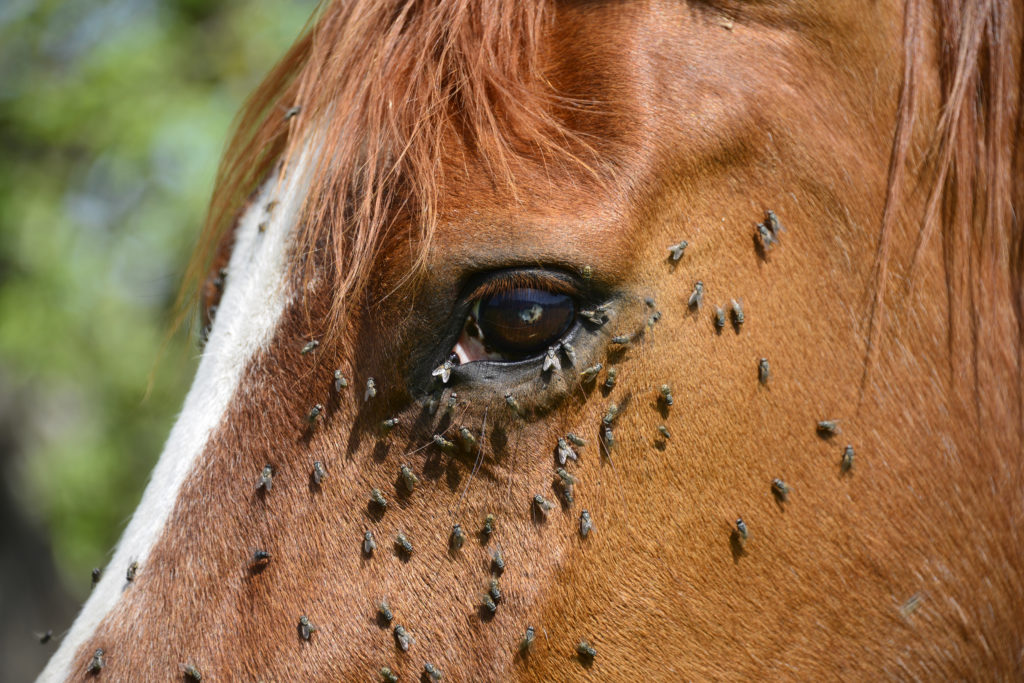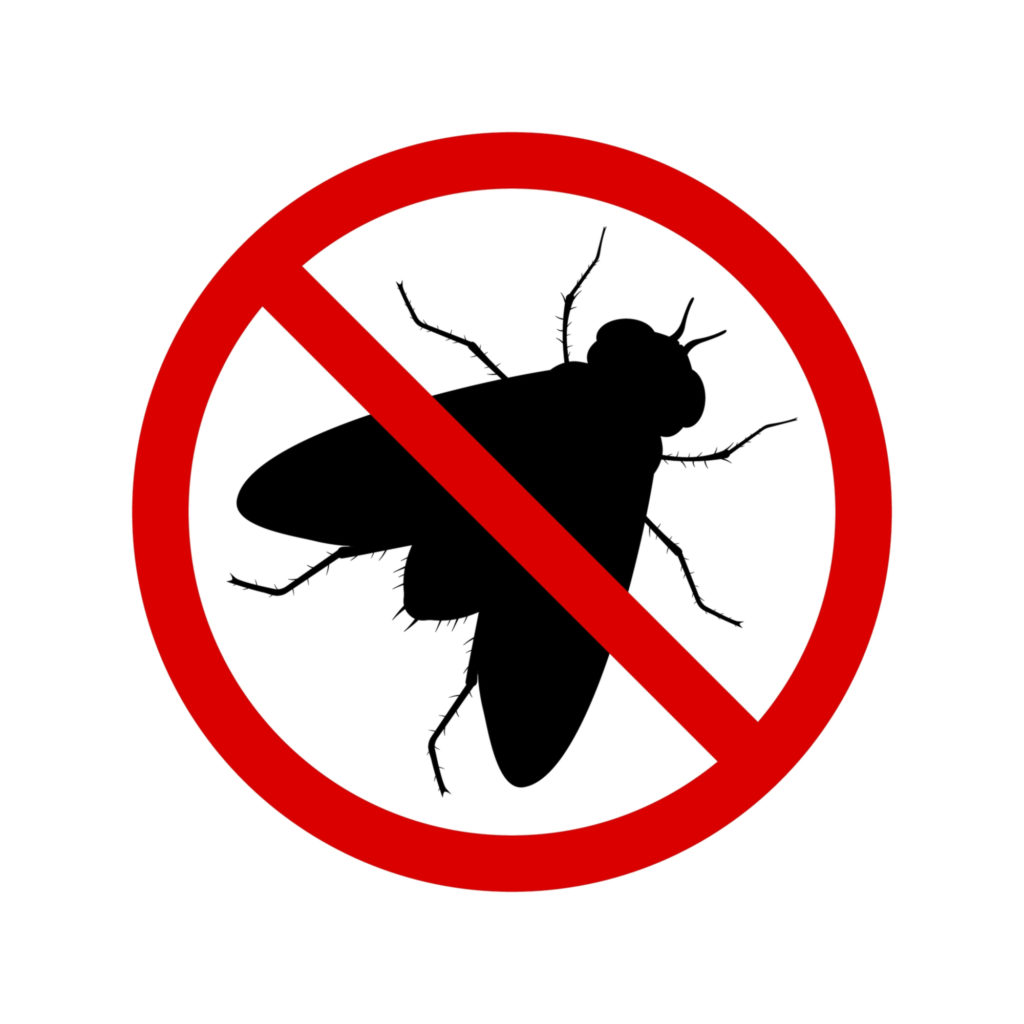Flies and why we need to control them
By Dr Jim Rawlinson, BVMS MBA MRCVS
Flies and why we need to control them
Fly control is an issue all horse owners must tackle. At best, flies are an annoyance, at worst, they cause serious distress to horses and can transmit bacteria, viruses and parasites. Flies vary in size, habitat and feeding patterns, all of which pose individual challenges to control.
Flies are divided into two categories: biting and non-biting flies.
Biting flies feed on animal blood. The bites can be painful, illicit allergic reactions, and spread disease. This group includes horse flies, midges, mosquitoes, black flies, and stable flies, among others.
Non-biting flies do not feed on blood; they instead feed on bodily secretions such as mucus. Both biting and non-biting flies can transmit diseases to horses and other domestic animals.
It is also worth mentioning that as well as biting, flies can cause damage to hosts by laying larvae in the skin. This can cause a condition known as myiasis (flystrike), which can be devastating if not caught and treated early. Although more common in rabbits and sheep, horses can also suffer from myiasis.
While the most significant threat flies tend to pose to horses in the UK is annoyance, fly control is still vitally important to maintain animal welfare and performance. So far in the UK, there is little threat from disease spread from flies compared to other countries. That being said, Equine Infectious Anaemia (EIA) is seen worldwide and is endemic in Europe.

Equine Infectious Anaemia
Equine Infectious Anaemia (EIA) is a viral disease of equids that causes intermittent fever, anaemia, emaciation, and in some cases, death. Signs may vary depending on the stage of the disease, but early signs include bleeding, swelling and jaundice.
EIA is a notifiable disease and has strict control measures in place to reduce spread. Infected animals must be humanely euthanised, and horses that have been exposed must be quarantined for at least 60 days while regular testing is undertaken. Infected horses, even those with mild signs, become carriers of the disease and are considered to be potentially infectious for life.
The spread of EIA can be transmitted by contaminated blood products or from mother to foal in utero. However, the most common transmission route is through insects, particularly horse flies (Tabanids) and some Stomoxys species (the Stable Fly is in the stomoxys family).
Luckily, at present in the UK, horseflies do not transmit EIA. Yet, with rising climates, it is imperative to be alert and aware of ways to combat these flying vectors.
The Horse Fly
Horseflies are persistent, aggressive, and hard to control. Although referred to as a horsefly, these flies from the Tabanidae family are attracted to multiple mammal species, as they require proteins in mammalian blood to reproduce.
They are attracted to warmth, smell, bright light and the exhaled carbon dioxide in a horse’s breath. They also prefer horses with darker coats because they are polarotactic – attracted to polarised light reflected by dark skin. Striped, spotted, and white coats (or rugs) reflect depolarised light, making it less attractive to the horseflies, and it is for this reason many fly rugs have been designed with stripes and spots on them.
They are also strongly attracted to odour – sweat and urine will increase the chances of attracting horseflies, so it is important to wash horses, and clean stables, regularly.
Horseflies have particularly painful bites due to having six stylets in their mouthparts which slice into the skin, and their saliva contains compounds that promote bleeding and prevent clotting. As their bites are so painful, they often become dislodged mid feed, due to horses swishing and kicking at them, resulting in persistent bites on the same animal.
Midges
With regards to flies causing horses annoyance, perhaps the most irritating of them all is the midge (Cullicoide). These tiny flies swarm and bite horses, particularly in the mane, tail and belly region. This is an uncomfortable sensation but can also cause more damaging effects in horses who are allergic to their bites. Some horses develop a hypersensitivity to the saliva of midges – the allergens in the midge’s saliva bind with Ig-E, causing an allergic reaction. This hypersensitivity is known as Ig-E mediated allergic dermatitis.
In layman’s terms, this condition is referred to as ‘sweet itch’. Characterised by horses intensely rubbing the affected areas (mane and tail) on solid structures such as fencing. Sweet itch can range in severity – some horses suffer broken hair or patchy hair loss, whereas others continue to itch until the skin is broken and raw, leaving oozing lesions.
Culicoides are also responsible for transmitting the parasite that causes onchocerciasis in horses – a condition that causes itching and skin irritation.
If possible, horses should be stabled when midges are most active. Most active at dawn and dusk, midges favour wet, marshy areas. As they are poor fliers, using a fan outside the stable helps prevent them from entering. A well-fitted fly rug is also essential for horses who suffer from sweet itch.
The Stable Fly
As the name suggests, the Stable Fly is often found around stables and livestock. Its Latin name, Stamoxys calcitrans, means ‘sharp mouth’, also describing its biting tendencies. Unlike many other blood-feeding flies, both sexes feed on hosts, which tends to be in the early morning or late afternoon.
Stable flies tend to bite horses on the legs, stomach and teat area. As well as being a nuisance – notice horses stamping legs and biting at their bellies – they also transmit disease. They are the intermediate host for the stomach worm, Habronema muscase. Currently with our temperate climate, the incidence of these nematodes is rare, but with increasing temperatures, they may become more common. Stable flies also carry the eye worm, Thelazia, whose larvae can cause lesions in the conjunctiva of the eye.
The Black Fly
Flies can also spread viruses from one location to another on the same horse. Culpable for this is the Black Fly. Small and annoying these flies target the horse’s face- particularly the ears. It is thought that Black flies are involved in the development of aural plaques and potentially have a role to play in spreading sarcoids on a horse’s body.

Fly Prevention
It is difficult to shied horses thoroughly with many different species of flies, who all have their own preferences for environment and feeding times. However, the following precautions should be observed to help reduce the burden of flies:
- Clean environment. Regularly removing soiled bedding removes the appealing odour of urine and clearing faeces reduces the breeding site for many flies. Good stable and yard hygiene should include stables being mucked out daily and paddocks poo-picked each day. It is important to keep the manure pile some distance from the stable yard to reduce contact of flies and horses.
- Physical barriers. The use of fly rugs and fly masks create a physical barrier to prevent flies from biting. It is imperative that these items fit correctly to avoid gaps that flies can enter from or sores and rubbing from incorrect fit. Striped, spotted, or white rugs deter horseflies.
- Chemical deterrents. There is a multitude of fly sprays available. Products containing highly effective active ingredient D.E.E.T. will be advantageous.
- Avoid certain times of day where possible. Midges are active at dawn and dusk, so stabling horses at these times will reduce contact time. Similarly, horseflies prefer bright sunlight – providing shade will give horses somewhere to go to avoid them.
- Avoid damp areas. Midges and many flies swarm over water, be that water troughs, rivers or damp woodlands. Horses should be kept away from these areas as much as possible.
- Midges struggle to fly in winds above 7mph so turning horses out on high ground with good airflow or increasing airflow in the stable helps to reduce midge activity.
For more top tips click here
To find a stockist click here
To see the Nettex Equine Fly and Midge Control Ranges click here






